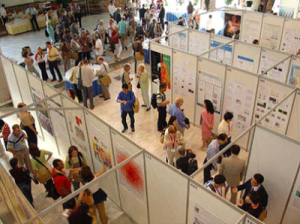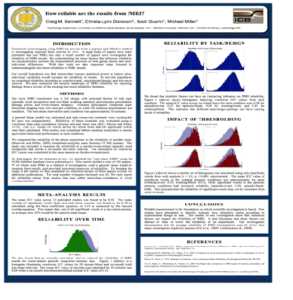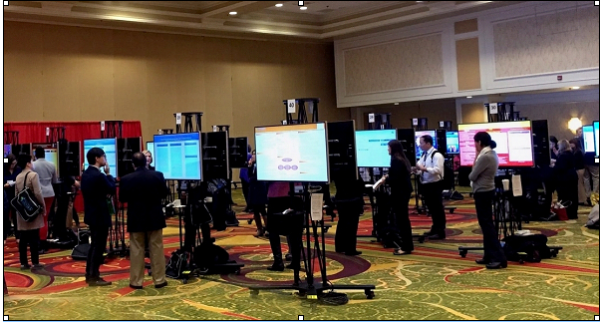Participants will be able to get their name badge and bag with materials at the registration desk on 9:00 a.m., or when they arrive at the congress.
POSTER PRESENTATIONS
Printed posters
A printed poster consist of a paper plate or sheet (it can be carried on rolled) that is fixed on boards or surfaces placed at the congress site. Posters will be exhibited in a sector of the Entrance hall. Authors may put up their posters on 9:00 a.m. The posters will be displayed during the whole congress.


It is the responsibility of the presenters to bring, put up and take down their posters. Authors are expected to be available near their posters during the poster sessions, coincident with the coffee breaks.The poster should be a presentation that graphically translates the contents of the full paper to be published in the proceedings of the congress, but without necessarily reproducing the whole text identically. Size: The maximum size is 60 × 120 cm, vertical orientation. A single sheet poster that is A0 portrait format (84.10 × 118.90 cm) will also be suitable. It is one poster per paper. Realization of the poster: If you are not familiar with specific graphic software that allow to design posters like these, you can simply use the PowerPoint. In this case, make a single slide having the real size of the poster: Select >File >Page settings >Personal size, and enter the width and height (for instance, 90 cm width and 130 cm height). Once the design of the poster is finished, you can export to a PDF file (or directly use the original PPT file) and have it printed in some shop with plotters or printers that allow large size printouts.
Language: The text of the posters should be written in one of the CleanWAS official languages:
Chinese, English, or Malay.
Text: The poster should be easily readable at a distance of 2 meters. Use upper and lower case for general content as the use of all-capital text is difficult to read. Avoid using mixtures of type/font styles. Use left aligned text, as it is easier on the eyes of the reader (justified paragraphs often leave undesirable gaps between words, especially if the text is arranged in narrow columns).
Recommendations:
Size of characters Case / Style General advice
Title 20-24 mm or 100
points, maximum
Title case / Bold At the top of the poster include the title of the presentation, the name of the authors and the institutions where they belong.
Headings suggested: 48 points
maximum: 60 points
Title case To divide text sections with appropriate headings makes reading easier.
Content 24-28 points
maximum: 32 points
Single spaced Upper and lower case
The text should be as short as possible. The description of the methodology used should be simple and concise.
Examples of posters: https://picasaweb.google.com/109164656093644460392/Posters#
Graphs/photographs: In order to have a good visual effect, it is recommended that graphs and images be no smaller than 12 × 18 cm.
Removal of posters: Posters must be removed at the end of the congress. The organizers are not responsible for posters not collected by their authors.
POSTER PRESENTATIONS
Digital posters
The digital poster may be a PowerPoint file with slides of normal size (landscape orientation), set to run with automatic transition of slides. It is recommended, once the design is finished, to save it in PPS format. Also, the digital poster may be a video or animation made with other kind of software, saved in one of these formats: MPG, AVI, WMV, or MOV. In both cases, the total duration is 5 minutes, maximum. The digital poster should not have sound, only text and still or moving images. The reason is that while the poster is running the author can speak and explain it to the audience gathered around. And also that the audience can talk to the authors without the interference of background noise. The poster should have a first slide or screen that includes the title of the presentation, the name and institution of the authors. In the subsequent slides, screens or sections, please include a tag or footnote (in small size) with the title of the paper (if it is long, summarized) and the author’s last name. In this way, the audience that eventually start seeing the sequence when it is already running, will still have the data of the presentation.
Language: The text of digital posters must be written in one of the official languages of the Clean WAS: Chinese, English, or Malay.

Text size: The digital poster should be readable at a distance of 5 meters. The digital posters will be exhibited in a sector of the Entrance hall, projected on a surface with a computer (provided by the organizers of the congress) and a digital projector, in a similar way as videos are often shown in some museums. There will be specific sessions for digital posters during the coffee breaks. In these sessions, the authors that are programmed at each opportunity will be able to present their work to the audience gathered around this sector. In addition to this, the digital posters will continue being projected at all moments during the conference (in a continuous sequence). There will always be a person from the organization staff in charge of these projections, and to give technical support to the authors of this modality of presentation. If an author wishes to present or explain the digital poster in front of a group of people at any time beyond the coffee breaks, this can be also freely arranged.
NOTE OF CLARIFICATION
The different modalities of presentation (oral and posters) do not imply differences in quality of the papers, and only concern the presentation on site. For the publication in the proceedings of the conference, no difference is made between oral and poster. All papers are published in the same way, with the same extension, and in the form of an article. The aim of these different forms of presentation at the congress site is to offer the best possibilities of exhibition to all papers, by reducing the number of parallel oral sessions to a minimum, and by allowing adequate graphic displays (that can be shown without the time limitations imposed by oral presentations) to the papers that require this. Nor does this imply that the authors of posters need not attend the congress. All the authors should be present (at least one author or coauthor per paper) in order to expose his or her proposal in person and discuss with the public.
